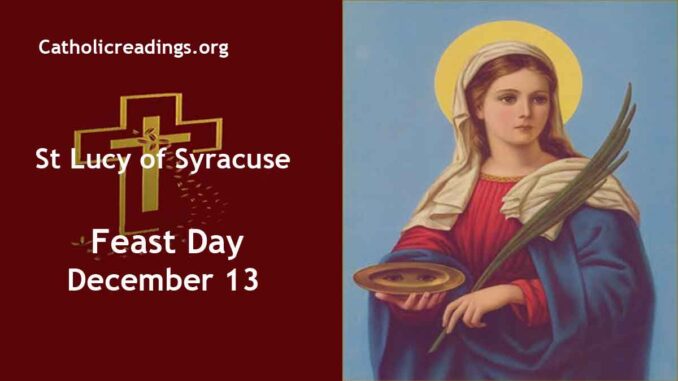St Lucy was also known as Lucia of Syracuse.
She was a virgin and martyr who is explicitly commemorated by Catholics in the Canon of the Mass.
She was born in 283 AD in Syracuse, Sicily and died in 304 AD in Syracuse.
We celebrate her feast day on December 13 every year in the Catholic Church.
| St Lucy Biography | |
|---|---|
 |
|
| Date of Birth | 283 AD |
| Place of Birth | Syracuse, Sicily, Italy |
| Place of Work | Syracuse, Italy |
| Date of Death | 304 AD |
| Place of Death | Syracuse, Italy |
| Feast Day | December 13 |
| Canonization | By Pre-Congregation |
| Patron Saint of |
|
St Lucy of Syracuse Life History
St. Lucy, a courageous woman from Syracuse, met her death during the persecution of Christians in the early fourth century.
Her courage became widely recognized in Rome, and by the sixth century, the entire Church acknowledged her commitment to defending the faith.
Given the loss of historical records about Lucy’s life, legends arose to illuminate her bravery. One credible narrative recounts the tale of a young Christian woman who pledged perpetual virginity in devotion to Christ.
Faced with her mother’s attempts to arrange a marriage with a pagan, Lucy, aware that her vow would not easily sway her mother, devised a plan to convince her that a life with Christ was the superior choice.
Eutychia, the mother of St. Lucy, endured a four-year struggle with a blood-related ailment that defied human intervention.
St. Lucy, recalling a similar healing in the Gospel, encouraged her mother by mentioning St. Agatha, affirming that she stands in the presence of the One for whom she sacrificed her life.
St. Lucy advised her mother to approach St. Agatha’s tomb with faith, assuring her that healing would follow.
They dedicated the night to prayers at the tomb of Saint Agatha in Catania, situated less than 50 miles from Syracuse, until both were overtaken by exhaustion and fell asleep.
St. Agatha appeared in a vision to St. Lucy, addressing her as a sister, and predicted her mother’s recovery and St. Lucy’s own martyrdom.
Instantly, the healing took place, prompting the mother to express gratitude. In appreciation, she permitted her daughter to share her wealth with the less fortunate and devote her virginity to Christ.
Word spread to Lucy’s spurned suitor that her inheritance and jewels were being distributed. He reported her to Paschasius, the Governor of Syracuse.
Despite the governor’s efforts to compel her into defilement at a brothel, Lucy remained immovable, even when tied to a team of oxen by the guards sent to take her away.
In an attempt to execute her, the guards surrounded her with bundles of wood, but it refused to ignite. Eventually, resorting to their swords, they thrust one into her throat, leading to Lucy’s demise.
While the specifics of her life remain obscure, it is widely acknowledged that Christians faced persecution for their faith during her era.
The followers of Christianity were subjected to brutal torture and frequently experienced agonizing deaths under the rule of Diocletian.
Though the circumstances of her demise are only preserved in the form of legends, contemporary Christians rely on these accounts.
The tale of Lucy extends beyond her death. According to later narratives, Lucy forewarned Paschasius of impending punishment.
In response, the governor ordered the guards to gouge out her eyes. In an alternative version, Lucy herself removed her eyes to dissuade a persistent suitor who admired them greatly.
During the preparation of her body for burial, it was revealed that her eyes had been miraculously restored. This is one of the reasons why Lucy is revered as the patron saint for those with eye illnesses.
Lucy, whose name signifies “light” or “lucid,” is the patron saint of the blind. She is frequently portrayed with the symbol of eyes on a cup or plate.
In artistic representations, she is commonly shown holding a golden plate bearing her eyes and a palm branch, symbolizing triumph over evil.
Sigebert, a monk from Gembloux, penned a sermon titled “Sermo de Sancta Lucia,” recounting that Lucy’s body remained undisturbed in Sicily for 400 years.
Eventually, Faroald II, Duke of Spoleto, took control of the island and transported Lucy’s remains to Abruzzo, Italy.
In 972, Emperor Otho I relocated her relics to Metz, placing them in the church of St. Vincent. What transpired after their time at St. Vincent’s is unclear, but it is believed that various fragments of her body are scattered across Rome, Naples, Verona, Lisbon, Milan, Germany, France, and Sweden.
St Lucy of Syracuse is the Patron Saint of
- The blind
- Martyrs
- Perugia, Italy
- Mtarfa, Malta
- Epidemics
- Salesmen
- Syracuse, Italy
- Throat infections
- Writers
- Sasmuan, Pampanga, Philippines
Today’s Saint Lucy of Syracuse Feast Day Quote:
The Saints had to bear sufferings and temptations greater far than yours. How did they overcome them? By the love of Christ.
Nourish this pure love by meditating on the mysteries of Christ’s life; and, above all, by devotion to the Holy Eucharist, which is the antidote against sin and the pledge of eternal life.
Related Links
Powered By SEO Experts
Follow @ReadingCatholic